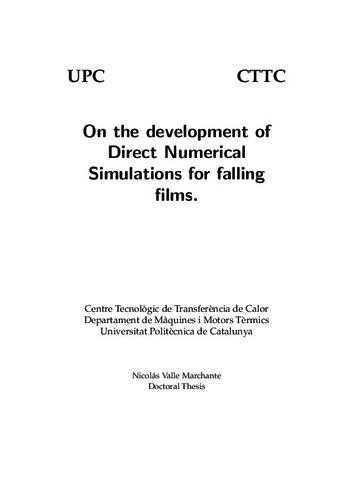Mostra el registre d'ítem simple
On the development of direct numerical simulations for falling films
| dc.contributor | Castro González, Jesús |
| dc.contributor | Oliva Llena, Asensio |
| dc.contributor.author | Valle Marchante, Nicolás |
| dc.contributor.other | Universitat Politècnica de Catalunya. Departament de Màquines i Motors Tèrmics |
| dc.date.accessioned | 2021-05-09T00:03:16Z |
| dc.date.available | 2021-05-09T00:03:16Z |
| dc.date.issued | 2021-01-07 |
| dc.identifier.citation | Valle Marchante, N. On the development of direct numerical simulations for falling films. Tesi doctoral, UPC, Departament de Màquines i Motors Tèrmics, 2021. DOI 10.5821/dissertation-2117-345318. |
| dc.identifier.uri | http://hdl.handle.net/2117/345318 |
| dc.description.abstract | Multiphase flows present a rich variety of physical instabilities, which may turn into a set of interesting techonological features. In the particular case of vertical fallings films, these features provide with short residence times, good heat transfer coefficients and low pressure drop, which make them good candidates for the heat and mass transfer demands of absorption chillers, amid many other thermal and chemical applications. The adoption of a discrete vector calculus approach for the numerical treatment of such flows present with two synergistic advantages: on the one side, the deployment of numerical methods into massive supercomputing systems is favourished while, on the the other hand, the mathematical properties of the resulting algorithms can be conveniently revealed. Similarly to the symmtery-preserving ideas in place for the Direct Numerical Simulation of single phase turbulent flows, and equipped with the aforementioned mathematical machinery, a novel physics-compatible discretization for the numerical computation of multiphase flows is presented which, similarly to its single phase counterpart, preserves energy at the discrete level. The new method introduces the first variation of area in the context of a the Conservative Level Set method to match the kinetic energy contribution due to the capillary forces with the potential energy variation due to the interface deformation. This requires for the reormulation of the high ressolution scheme used for the transport of the marker function from an algebraic perspective, which ultimatelly yields to the design of a novel curvature interpolator. In addition, the adoption of a consistent mass and momentum discretization is presented in terms of the aforementioned algebraic approach, resulting in the anounced energy-preserving level set method. |
| dc.description.abstract | Els fluxos multifàsics presenten una rica varietat d’inestabilitats físiques, que poden resultar en un conjunt d’interessants característiques tecnològiques. En el cas particular de les pel·lícules descendent verticals, aquestes característiques proporcionen temps de residència curts, bons coeficients de transferència de calor i baixa pèrdua de càrrega, que els converteixen en bons candidats per als fenòmens de transferència de calor i massa típics dels refrigeradors d’absorció, entre d'altres moltes altres aplicacions tèrmiques i químiques. L’adopció d’un enfocament de càlcul vectorial discret per al tractament numèric d’aquests fluxos presenta dos avantatges sinèrgics: d’una banda, s’afavoreix el desplegament dels mètodes numèrics en superordinadors, mentre que, d’altra banda, les propietats matemàtiques dels algoritmes resultants es poden avaluar convenientment. De manera similar a les idees symmetry-preserving existents per a la simulació numèrica directa de fluxos turbulents d'una sola fase, i equipades amb la maquinària matemàtica esmentada, es presenta una nova discretització compatible amb la física per al càlcul numèric de fluxos multifàsics que preserva l’energia dins del context del Conservative Level Set method. El nou mètode introdueix la primera variació d'àrea en el context d'un Conservative Level Set Method i fa coincidir l'aportació d'energia cinètica deguda a les forces capil·lars amb la variació d'energia potencial a causa de la deformació de la interfície. Això requereix la reformulació de l’esquema d’alta resolució utilitzat per al transport de la funció marcador des d’una perspectiva algebraica, que últimament resulta en el disseny d’un nou interpolador de curvatura. A més, es presenta l’adopció d’una discrecionalització consistent de la massa i el moment lineal en termes de l’esmentat enfocament algebraic, donant lloc al mètode Energy-preserving level-set. |
| dc.format.extent | 136 p. |
| dc.language.iso | eng |
| dc.publisher | Universitat Politècnica de Catalunya |
| dc.rights | L'accés als continguts d'aquesta tesi queda condicionat a l'acceptació de les condicions d'ús establertes per la següent llicència Creative Commons: http://creativecommons.org/licenses/by/4.0/ |
| dc.source | TDX (Tesis Doctorals en Xarxa) |
| dc.subject | Àrees temàtiques de la UPC::Física |
| dc.title | On the development of direct numerical simulations for falling films |
| dc.type | Doctoral thesis |
| dc.identifier.doi | 10.5821/dissertation-2117-345318 |
| dc.rights.access | Open Access |
| dc.description.version | Postprint (published version) |
| dc.audience.degree | DOCTORAT EN ENGINYERIA TÈRMICA (Pla 2012) |
| dc.identifier.tdx | http://hdl.handle.net/10803/671507 |
Fitxers d'aquest items
Aquest ítem apareix a les col·leccions següents
-
Departament de Màquines i Motors Tèrmics [75]
-
Totes les tesis [5.459]


